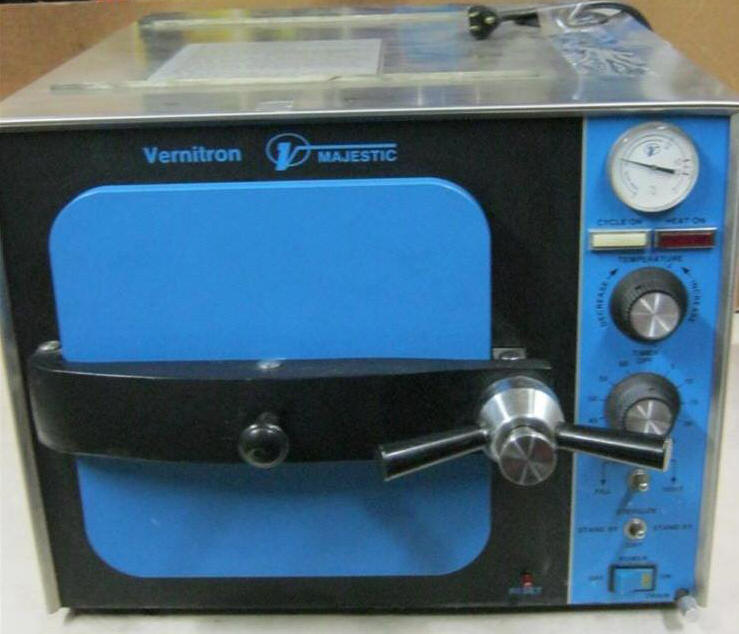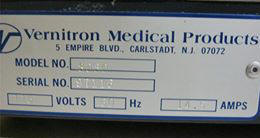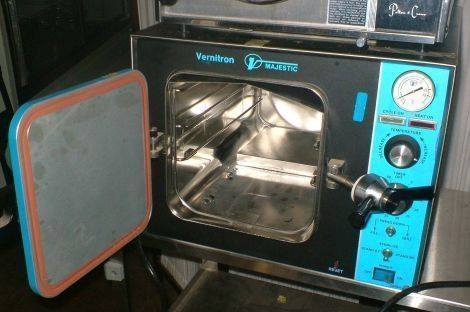
FDA Enforcement Report
Snap shot as of 9/18/08
The FDA Enforcement Report is published
weekly by the Food and Drug
Administration, U.S. Public Health
Service, Department of Health and Human
Services. It contains information on
actions taken in connection with agency
regulatory activities.
http://www.fda.gov/bbs/topics/ENFORCE/ENF00058.html
 |
Product: Vernitron Majestic Table Top Sterilizers, Models
8080,
V8000, or R816 a table top steam
autoclave with an
8" x 8" x 16" chamber. Recall
#Z-738/740-0.Code:
All of the above model numbers
manufactured prior to 1985. (note:
these autoclaves were used to sterilize
the Ped-o-Jet Jetguns used by the
military. Sterilization could not be
guaranteed.)
|
Manufacturer:
Vernitron Better Built Corporation (OOB),
Carlstadt, New Jersey. |
 |
Recalled by:
Vernitron Medical Products, also known
as Ped-O-Jet International, Dayton, New
Jersey, by letter
February 26, 1990. Firm-initiated field
correction ongoing.
Distribution:
Nationwide, Canada, Korea.
Quantity:
Firm estimates fewer than 100
uncorrected units remain on market.
Reason:
The locking hub may detach from the unit
at high pressure as a projectile and may
also cause a compromise of sterility
of the contents of the sterilizer.

The
following
article was
originally
published in
Preventing
Infection in
Ambulatory Care,
the quarterly
e-publication
from the
Association for
Professionals in
Infection
Control and
Epidemiology (APIC).
To learn more
about receiving
this resource
and joining APIC,
visit
www.apic.org/ambulatorynewsletter.
To learn more
about APIC,
visit
www.apic.org.
The
sterilization of
instruments and
supplies in an
outpatient
setting is often
accomplished
using a desktop
autoclave.
Regardless of
the size and
scope, basic
principles of
sterilization
must be met to
ensure patient
safety. It is
crucial to
remember that it
is against
federal law to
reuse or
reprocess
instruments and
items labeled
"Single Patient
Use."
These items may
be sent to a
third party
reprocessor
licensed by the
Food and Drug
Administration
to reprocess
specific
instruments and
medical devices.
Older
autoclaves
without alarm
features and
with only a
temperature and
pressure gauge
MUST be watched
to ensure that
correct
temperature and
pressure are
reached and
maintained
during the
entire cycle.
Because of this,
older autoclaves
are not
generally a good
choice and
should be
replaced with a
newer product;
preferably one
that prints out
a load report.
Flow
of Instruments
for Processing
All
instrument
processing areas
must be set up
to provide
unidirectional
flow of
instruments from
soiled receiving
to processed
packages, sets
and trays ready
for use. Flow
should be in one
direction with
no crossovers or
places where
there could be a
mix-up of clean
and dirty items.
Physical
Cleaning
Once
received, soiled
instruments are
rinsed and/or
wiped to remove
gross debris,
then soaked or
washed in an
enzymatic
detergent and
scrubbed to
remove all
debris.
Instruments may
be soaked until
a staff member
is available to
begin to process
them. Scrubbing
to remove all
traces of debris
is critical,
with special
attention to
grooves, joints,
ridges, etc.,
that can trap
blood, tissue or
the like.
Brushes used for
this should be
washed and
disinfected
periodically,
and replaced
when no longer
functional.
Packaging
Instruments
may be packaged
individually in
peel packs or as
small sets in
larger peel
packs such as a
staple remover
set, or in small
wrapped packs or
trays. The pack
must be
appropriate for
the type of
autoclave: steam
or gas.
Peel packs
allow
visualization of
the item through
the clear panel
and can be
turned out onto
a sterile field
or opened and
held for someone
with sterile
gloves to take
and use. The
peel pack should
be the correct
size for the
instrument in
order to prevent
tearing of the
package. Tip
guards, cotton
or gauze should
be used to
protect sharp
points from
penetrating the
packaging.
Hinged
instruments
should be placed
in the pack in
the open
position to
ensure
penetration of
steam. Staff
must be aware of
how to position
instruments in
the packs, which
will depend on
whether the item
will be opened
and held for a
person with
sterile gloves
to remove from
the package, or
be turned out
onto a sterile
field.
Wrapped packs
are usually used
for sets of
instruments,
such as an
incision and
drainage tray.
Reusable textile
or disposable,
non-woven
materials may be
used for
wrapping. There
is a limit to
the size and
density of packs
and trays to
ensure steam
penetration.
Autoclave tape
is often used to
close the packs.
Process
Indicators
There are
several types of
process
indicators that
can be used to
help assure
sterility of
processed items.
Many peel packs
come with a
color-change
indicator right
in the material
itself; some
have indicators
for both steam
and gas
processing. When
exposed to the
autoclave, the
package color
changes. This
indicates that
the package has
been through the
autoclave, but
does not assure
sterility.
Autoclave tape
is another
color-change
indicator.
Internal
chemical
indicators
monitor one or
two parameters,
such as
temperature and
time, and are
placed inside
the packs or
trays and will
indicate steam
penetrated to
the center of
the pack for the
right amount of
time. If the
color change
does not occur,
do not use the
item.
Chemical
integrators are
also placed deep
inside packs and
trays and
demonstrate that
three specific
parameters of
time,
temperature,
and the presence
of saturated
steam have been
met. If these
devices are not
visible, persons
opening packs
must check to
ensure the pack
or tray is safe
to use. Do not
use if the
integrator has
not changed
appropriately.
Desktop
sterilizers
should have a
printout
confirming that
the proper time,
temperature and
pressure were
achieved. These
should be filed
and should
include the
day's date and
load number.
The "gold
standard" for
monitoring steam
sterilizers is
the biological
indicator, or
BI, which is a
device that
contains a
viable
population of
microorganisms,
usually
bacterial
spores, that are
resistant to the
type/method of
sterilization
being monitored.
These come in
different
formats,
including spore
strips (often
sent out for
processing) and
capsules that
are processed
deep in a load,
incubated, and
read in the
clinic or
office. This
definitively
shows that the
conditions
required for
sterilization
have occurred.
BIs should be
run at least
weekly, or with
each load if the
autoclave is
used less than
once a week.
Some users run a
BI daily.
Sterilizer
Failures
What happens
if the BI is not
sterilized
during
processing? All
the instruments
that were
processed since
the last "good"
BI must be
identified and
pulled,
unpackaged and
reprocessed. To
identify
implicated
items, packages
must be labeled.
Many clinics
simply note the
date processed
and the load
number for that
day on each
package. Clinics
must have a
written policy
and procedure of
how to recall
and reprocess
instruments, as
well as
notification of
providers whose
patients were
treated with
these
instruments.
Some providers
will notify
patients while
others will
watch the wound
for evidence of
infection or
prescribe
additional
antibiotics.
The
sterilizer
should not be
used again until
the problem has
been identified
and corrected,
and several test
loads have been
successfully
processed with
"good" BI
results.
Sterilizer
Maintenance
As with any
mechanical
equipment,
autoclaves need
preventive and
periodic
maintenance,
based on the
manufacturer's
recommendations.
This must be
performed by
knowledgeable
technicians at
specified
intervals, and
maintenance
should be
documented and
kept on file.
There is daily
and weekly
cleaning that
must be done.
The racks inside
must be removed
and the interior
cleaned each
week. Distilled
water reservoirs
must be drained
and emptied,
then refilled.
Keeping Packages
and Trays
Sterile – Proper
Storage
Once the
right processes
are in place and
instruments are
being correctly
managed, it is
important to
ensure that
stored packs and
trays remain
sterile. How
long is a pack
or tray "good"
for? 30 days? 60
days? Longer?
Shorter?
Sterility of an
item is not
related to TIME,
but to EVENTS
that the pack
undergoes.
Therefore,
proper storage
and rotation of
instruments is
essential and
should include
the following:
- Store in
closed
cabinets
away from
sources of
heat and
moisture.
- Separate
types of
instruments
using
washable
bins or
containers.
- Do not
stack heavy
sets on top
of each
other.
- NEVER
put rubber
bands around
sterile
supply
packages.
The wrapper
edges may
become
nicked or
torn and
render the
item
contaminated.
Use bins or
containers.
- Be
careful not
to overstuff
drawers if
used for
storage. The
opening and
closing of
the drawer
and/or hands
rifling
through
packages can
cause tiny
holes or
tears.
- Any
package that
falls on the
floor is
contaminated
and is not
to be used.
- Any
package
wrapper with
evidence of
tears,
holes,
moisture,
water spots,
etc., may
not be used.
- Any
package
where the
external or
internal
indicators
or
integrators
have not
turned the
appropriate
color may
not be used.
- Sterile
packs and
trays should
be opened
immediately
before use.
It is NOT
acceptable
to open and
leave or
cover
instruments.
- Sterile
instruments
are
generally
handled with
sterile
gloves or
sterile
forceps, and
a sterile
field must
be
established.
Pitfalls often
observed in
desktop
sterilizer
processing:
- Failure
to
thoroughly
clean
instruments
before
sterilization
- Use of
sterilizers
that do not
have
printouts
showing
parameters
were met
- Improper
packaging:
sharp points
puncturing
peel packs,
hinged
instruments
autoclaved
in the
closed
position
instead of
open, pack
too large or
too small
for the item
- No
documentation
of
preventive
maintenance
of the
autoclave
- Door
gaskets not
intact
- No
Biological
Indicators
(spore
tests) being
used or used
incorrectly
-
Instruments
wrapped
AFTER
sterilization
-
Instruments
sterilized
unwrapped
and placed
in unsterile
"boats"
- Use of
antiseptics
(formulated
for use on
skin) to
disinfect
instruments
- Use of
dishwashers
to "process"
instruments
- No
sterilization
logs, no BI
results logs
-
Reprocessing
of items
labeled
"Single
Patient Use"
References:
CDC Guideline
for Disinfection
and
Sterilization in
Healthcare
Facilities,
2008.
Read more
from APIC:
Environmental
Cleaning and
Disinfection:
What Infection
Preventionists
Need to Know
|